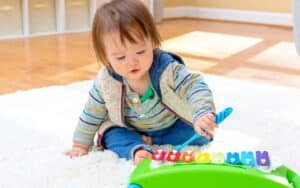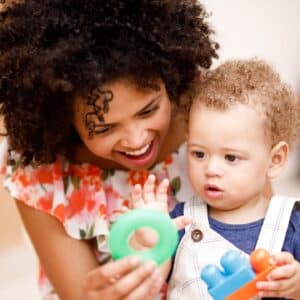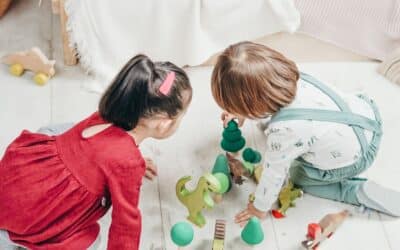Understanding the influence of toys during the first year is vital. Toys serve as the bridge between fun and learning. Understanding how to select and use toys to support your child’s development can transform simple playtime into a rich language and overall learning experience. choosing and using toys for infant learning.
Choosing Toys
There are so many toys available today. It can be a daunting task to figure the best toy choices to support infant fun and learning. When in doubt, think “old school.” Those tried-and-true toys that you may have played with as an infant are still often the best choices for your infant today. Look for toys that are simple, engaging, stimulate your child’s senses, and are easy to explore and manipulate in different ways. Toys such as colorful rattles, links, balls, busy boxes, stacking and nesting blocks, stacking rings, pop beads, musical toys, dolls, and stuffed animals are excellent choices. Cloth books and board books with realistic pictures are also important options. And don’t forget about household items that your child uses as toys such as boxes, plastic containers, and pots. Be sure to include them in the mix.
Safety First
First and foremost, ensure the toys your child plays with are age-appropriate, developmentally appropriate, safe, and free from small, detachable parts.
Using Toys
During infancy, a child learns through their senses and movement. They learn through what they feel, hear, see, taste, and smell and through movement and exploration.
Texture Play
Different textures provide unique sensory experiences to discover, explore, talk about, and learn from.
Top Picks:
- Textured plush toys.
- Cloth and board books with varied visuals and textures.
- Safe teething toys.
- Textured balls.
- Sensory play mats.

Sound Play
Toys can be a gateway to a world of sounds. Sound making toys can help develop a child’s auditory awareness, listening skills, and discrimination of sounds. This in turn will help them to distinguish speech sounds and sound patterns. Experiences with play involving sounds will build their listening skills and add to their ability to understand and use of speech and language.
Key Toys:
- A variety of rattles.
- Toys that make music such as crib mobiles.
- Squeezable noise toys.
- Simple musical instruments.
- Toys that make environmental sounds such as animal noises.

Visual Play
Engage your child’s vision with toys of varied colors and patterns. Infants are most visually responsive to high contrast colors and patterns.
Great Choices:
- High-contrast play mats.
- Colorful stackers and busy boxes.
- Books with colorful and non-cluttered illustrations.
- Varied colored blocks.
- Non-breakable mirror.
Strategies for Effective Play
Toys are only part of the process. The interaction between the parent and child is the super sauce. In fact, you are probably your child’s favorite toy.
Modeling Actions and Language
Showcase how toys work. Use simple and engaging language to talk about what your child sees, hears, feels, and experiences while playing. This way, you offer your child consistent opportunities to pair words with what they represent.
Responding to Child’s Communication
Respond to your child’s communication attempts, be it through sounds, gestures, or facial expressions. Your prompt response to their efforts to engage, interact, and tell you something with their actions shows them that their communication efforts are important and encourages them to communicate more.
Self-talk and Parallel Talk
Narrate what you’re doing. For example, you could say, “Mommy is stacking blocks. They go up, up, up.”. Describe what your child is doing. You could use words such as, “You’re shaking the rattle. Listen with your ears. Shake, shake, shake.”
Imitation and Repetition
Imitation and repetition are foundational for learning. Imitate what your child does and what they say. Show excitement and imitate what they do and what they say. Repeat important sounds, words, and actions in different situations.
Turn-taking Games
Teach the concept of back-and-forth play and vocalizing through turn taking. By taking turns with your child, you are building the basis for their learning to share and engage in conversation.
Follow the Child’s Lead
If your child shows interest in a specific toy or activity, follow their lead. Build upon their interest by using simple and engaging language to talk about what they are doing and experiencing. When you follow their lead and interest, you tap into their motivation to explore, communicate, and learn.
Incorporating Play into Daily Routines
Make playtime fun, educational, predictable, and matched to your child’s developmental level, attention, and interests. Incorporate play into your child’s daily routines such as mealtime, bathtime, community outings, and other routines. Remember, a toy can be anything that is safe and interesting for your child including food, socks, boxes, pots, plastic containers, water and so much more.
FAQs
- Why the focus on toy textures?
- Children learn through their senses and the sense of touch is key learning mode during early development. Touching and exploring a variety of textures teaches children about the properties of things within their world.
- Do auditory toys assist in speech?
- Absolutely, they introduce various foundational sounds, support sound awareness, and help children distinguish between sounds. This helps them to recognize and understands speech sounds.
- Can structured play aid sleep patterns?
- Yes, as a part of a consistent daily routine, consistent play can lead to a stable sleep cycle.
- Are electronic toys beneficial?
- In moderation. Traditional toys such as blocks, balls, stacking rings, dolls, etc. and safe household items such as plastic containers offer broader developmental benefits.
- How often should I change toys?
- Rotating toys every few weeks will help to keep your child’s interest high and their engagement fresh. Absolute favorite toys may require consistent availability and not lend well to rotation.
Additional Resources
- Good Toys for Young Children by Age and Stage | NAEYC
- Best Toys for Babies & Toddlers | ZERO TO THREE
- Toy Buying Tips for Babies & Young Children: AAP Report Explained – HealthyChildren.org
- Printer-Friendly_you-are-childs-best-toy.aspx (hanen.org)
- How to Buy Safe Toys – HealthyChildren.org
- Use Household Items to Entertain Babies! | Baby Learning (pathways.org)
Conclusion/Summary
The article highlights the key role of choosing simple sensory-stimulating and interactive toys to enhance infant language learning and overall development. It emphasizes that while choosing the right toys is an important step, the active involvement of parents and caregivers in using these toys is crucial. Ultimately, the combination of appropriate toys and engaged play and communication from adults creates the best environment for fun, language learning, and infant development. So, let’s PLAY!!!




0 Comments